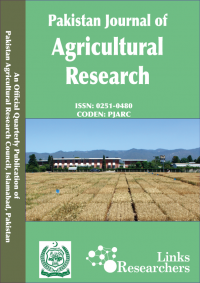INTERPRETING WHEAT GENOTYPES FOR GRAIN YIELD UNDER DIFFERENT REGIMES OF KHYBER PAKHTUNKHWA
Nasarullah*, Raiz uddin*, Fakhar Uddin* and Muhammad Jamal*
ABSTRACT
Pakistan has been blessed with wide range of environmental conditions ranging from plains to mountains. Wheat is grown throughout the country to feed more than 200 million people. To get maximum yield, high yielding genotypes suitable to diverse agro-climatic conditions are needed. However, so for few varieties have been developed that can efficiently grow in different environments. This is one of the reasons for lower wheat production in the country. Current experiment was conducted to monitor stability of yield potential of 15 diverse wheat genotypes at Skardu-Gilgit-Baltistan (Northern and mountainous region of Pakistan) and Peshawar, Khyber Pakhtunkhwa, during wheat crop season 2011-2012 using RCB design with three replications. The genetic material was comprised of 9 nationally released cultivars, three advance line from Tajikistan, one from China and two locally grown cultivars. The analysis of variance revealed significant differences among genotypes, locations and genotype by environment interactions for days to heading, days to maturity, plant height (cm), spike length (cm), spikelets spike , 1000-grain weight and grain yield. Flag leaf area (cm displayed non-significant differences across environments and its interaction with genotypes. Mean values across the environments range between 147.17 to 174.00, 190.83 to 202.83, 23.32 to 54.13,78.40 to 115.17, 9.72 to 13.08, 16.33 to 23.80 for days to heading, maturity, flag leaf area, plant height, spike length and spikelets spike , respectively. The estimates of broad sense heritability were high for all studied traits. Similarly, genetic advance was also high for all studied traits except days to heading and maturity where genetic advance was low. High heritability coupled with high genetic advance indicated the effectiveness of selection in early generation for the improvement of these traits. Genotypes Faisalabad-2008 and line from Tajikistan (2S-3094) performed better for most of yield and associated traits across both environments therefore could be an asset for plant breeders to breed genotypes suitable for diverse environments.
To share on other social networks, click on any share button. What are these?






